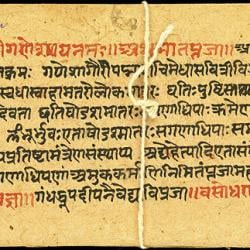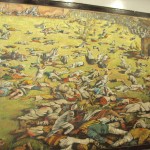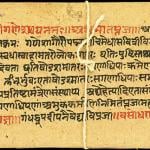Here are some interesting write ups that were posted by a commenter, Janet, at Intentblog in response to my article on Eternal Illusion
What about the Collapse of the Brain-wave?
“Consciousness causes collapse” is the theory that ‘observation’ by a ‘conscious’ observer is responsible for the ‘wavefunction collapse’ in ‘quantum mechanics’. It is an attempt to solve the ‘Wigner’s friend paradox’ by simply stating that collapse occurs at the first “conscious” observer. Supporters claim this is not a revival of ‘substance dualism’, since (in a ramification of this view) consciousness and objects are ‘entangled’ and cannot be considered as separate. The consciousness causes collapse theory can be considered as a speculative appendage to almost any interpretation of quantum mechanics and many physicists reject it as unverifiable and introducing unnecessary elements into physics.
It has been claimed that the theory meshes well with ancient Eastern mysticism and philosophy, including that of Buddhism which includes a belief in the transitory, interconnected nature of all things and the illusion of separation of thought and existence. This is one of the major themes of the book ‘The Dancing Wu Li Masters’. It also meshes well with the views of the ‘New Thought’ movement.
The view is also presented in the popular and controversial documentary What the Bleep Do We Know!?, alongside some unrelated biological discussions, and is a major plot point in Greg Egan’s novel Quarantine, as well as playing a significant role in Charlie Stross’s novel The Atrocity Archives.
Proponents:
“Esse est Percipi”: The idea of consciousness somehow being related to the creation of reality was first proposed by Bishop Berkeley. With the publication of Die Mathematische Grundlagen der Quantenmechanik, it was Von Neumann however who became the first person to hint that Quantum theory may imply an active role for consciousness in the process of reality creation. His followers Fritz London, Edmond Bauer, and Eugene Wigner carried Von Neumann’s argument to a claimed logical conclusion that consciousness-created reality is the inevitable outcome of Von Neumann’s picture of quantum theory.
Among other names that have expressed the belief that a deep connection exists between mind and quantum matter are Henry Stapp, Freeman Dyson, and Roger Penrose. Among the more recent followers one can find physicists Evan Harris Walker, Fred Alan Wolf, and Amit Goswami. However, none of these recent supporters hold any current positions at a reputable academic institution.
Criteria for consciousness:
The process of “measurement” in quantum mechanics is regarded to as consciousness itself. However, it is not explained by this theory which animals, living creatures, or objects have consciousness, that is, the power to collapse the wavefunction. It is also not clear whether measuring devices might also be considered conscious, though generally measuring devices are considered simply a “chain of observations” that only ends at a conscious entity. Some even suggest that some beings have a “higher consciousness” and therefore more capability to collapse the wavefunction, whereas others believe all conscious entities have an equal capability. Others believe that “higher consciousness” is inherent in all, but some have tapped into it more fully.
Quantum immortality:
Assuming that collapse of the wavefunction requires conscious observation suggests a curious type of immortality. Just prior to dying, a person necessarily loses consciousness; and an unconscious person cannot observe his death. Therefore, by the consciousness-collapse hypothesis, he does not register it. Moreover, by the ‘Copenhagan interpretation’, without registration the event is not personally experienced. Thus, in the ‘Schrodinger’s cat’ experiment, although the outside observer may open the box to find a dead cat, the cat does not perceive himself as dead. Now lacking consciousness, presumably some subconscious aspect of his state lives on. Notice that this route to ‘quantum immortality’ does not require the ‘many-worlds’ interpretation. That is, it is immaterial ‘where’ the individual ‘goes’ after the event. The point is that in his frame of reference he remains alive, albeit in some presently unknown, subconscious state.
One can speculate a bit further. The conscious and the subconscious are two different levels of mental activity. Therefore, presumably the subconscious state of the ‘dead’ cat is incapable of communicating with the conscious states of other living organisms. Rather, if communication is possible at all it would seem more likely to be with their subconscious states.
==========
The quantum mind or quantum consciousness is a protoscientific hypothesis that posits a connection between consciousness, neurobiology, and quantum mechanics. There are many gaps in current understanding of how consciousness arises, to the extent that we are uncertain whether it is strictly from the functioning of the human brain or if awareness involves more of our nervous system and/or other aspects of our totality. Some believe that the approach of strict reductionism and materialism does not adequately explain perception, cognition, or free-will in sentient beings, although it does account for our intelligence. It could be argued that a strictly classical interpretation of the Physics and Neurobiology involved does not even admit the possibility of free-will, or would assert that it is illusory, and has no clear explanation for the phenomenon of conscious awareness. Accordingly; the quantum mind hypothesis claims that only quantum mechanics is capable of explaining conscious experience.
…
Introduction
The exact nature of consciousness remains unknown. Many models of the mind view consciousness as computation among the brain’s neurons but as yet have failed to describe an exact mechanism. Quantum processes in the brain have been invoked as explanations for consciousness and its enigmatic features. Some theories have been subjected to experimental tests, and evidence has been claimed that indicates that processes occurring in conscious and subconscious brain functions are best explained by Bohmian mechanics; however, these results have not gained wide acceptance.
Supporters of the quantum mind hypothesis argue that the brain should not be seen as simply a vast piece of organic clockwork, but rather as a subtle device amplifying quantum events; that quantum computation would surely be advantageous from an evolutionary perspective; and that biology has had four billion years to solve the decoherence problem and evolve quantum mechanisms.
The main line of argument may be summed up as follows: human thought is said to be sound, yet non-algorithmic (following Gödel’s Incompleteness Theorem), and the human thinker is aware of the contents of these thoughts. Some say that the only recognized instances of non-algorithmic processes in the universe, based on accepted physical theories, are either purely random or the reduction of the quantum mechanical state vector. Randomness is not promising as the source of the non-algorithmicity needed to account for consciousness, therefore certain quantum mechanical phenomena must be responsible.
Critics deride this comparison as a mere “minimization of mysteries” (the term, coined by David Chalmers, suggests that since quantum and consciousness are both mysteries, they must be related) and point out that the brain is too warm for quantum computation, which in the technological realm requires extreme cold to avoid “decoherence” (i.e., the loss of seemingly delicate quantum states by interaction with the environment).
Some modern “New Age” writers have used the theory to support the belief that the human mind commands special powers – psychic forces – that transcend the material universe.
………..
Various quantum theories of mind:
Modulating quantum jumps
The first modern pioneer of this field was biologist Alfred Lotka, who in 1924 proposed that the mind controls the brain by modulating the quantum jumps that would otherwise lead to a completely random existence. However, the first detailed quantum model of consciousness was by a physicist, Evan Walker. In 1970 he proposed a synaptic tunneling model in which electrons can “tunnel” between adjacent neurons, thereby creating a virtual neural network overlapping the real one. It is this virtual nervous system that for Walker produces consciousness and that can direct the behavior of the real nervous system. In short, the real nervous system operates by means of synaptic messages while the virtual one operates by means of quantum tunneling.
…
Bose-Einstein condensates
In 1989 the British psychiatrist Ian Marshall examined similarities between the holistic properties of Bose-Einstein condensates and those of consciousness. In 1968 the British physicist Herbert Fröhlich had suggested that condensation similar to Bose-Einstein can be achieved in Nature by biological organisms which are in a non-equilibrium state. In Marshall’s hypothesis, the brain contains a Frölich-style condensate, and, whenever the condensate is excited by an electrical field, conscious experience occurs. Marshall theory contends that the brain would maintain its dynamical coherence due precisely to the properties of such a condensate.
Synaptic quantum uncertainty
John Carew Eccles suggested in 1986 that the synapses in the cortex may respond in a probabilistic manner to neural excitation; a probability that, given the small dimensions of synapses, could be governed by quantum uncertainty.
…
Consciousness as the observer
The philosopher Michael Lockwood noted that special relativity implies that mental states must be physical states. He argued that sensations must be intrinsic attributes of physical brain states. Thus in quantum terms each sensation corresponds to an observable event in the brain; this makes the observer, in quantum mechanics, conscious of the physical world.
…
Conscious matter
Nick Herbert, a physicist, has been even more specific on the similarities between Quantum Theory and consciousness. Herbert thinks that consciousness is a pervasive process in nature and that it is as fundamental a component of the universe as elementary particles and forces. James Culbertson, a pioneer of research on robots, has even speculated that consciousness may be a relativistic feature of space-time. In his opinion, too, consciousness permeates all of nature, so that every object has a degree of consciousness.
…
A tripartite model
American physicist Henry Stapp’s model of consciousness is tripartite in that each event is driven by three quantum processes operating in concert. The first is a mechanical, deterministic process that predicts the state of the system given its state at a given time. The second is conscious choice. In formal Quantum Theory it is implied that something can be known only when Nature is asked a question. This in turn implies the third process, that consciousness has a degree of control over Nature because each time something is learned there is a change in the state of the universe, which directly corresponds to a change in the state of the brain. In Quantum Mechanic terms: there occurs a reduction of the wave function compatible with the fact that something has been learned.
…
Thought as a hologram
Many properties of the brain are the same properties that are commonly associated with holograms: memory is distributed in the brain and memories do not disappear suddenly, but slowly fade away. To psychologist Karl Pribram, a sensory perception is transformed in a “brain wave”, a pattern of electromagnetic activation that propagates through the brain just like the wavefront in a liquid. The various waves that travel through the brain can interfere with each other. The interference of existing waves (a memory), and a fresh perceptual wave (sensory input) generates a structure (resembling a hologram) that is experienced as thought. Pribram refers to this as Holonomic brain theory.
…
Quantum neurophysics
The Heisenberg and Von Neumann tradition has always viewed the brain as a quantum measuring device, but others claim that brain substrates can hold second-order quantum fields, which cannot be treated as mere measuring devices. This is the position of Kunio Yasue, a Japanese physicist who has developed quantum neurophysics. Yasue presents the brain as a macroscopic quantum system wherein the classical world can originate from quantum processes. Since he is not a connectionist, Yasue sees the fact that neurons are organized inside the brain as irrelevant. See Quantum brain dynamics for references.
…
Space-time theories of consciousness
Alex Green has developed an empirical theory of phenomenal consciousness that proposes that conscious experience can be described as a five-dimensional manifold. As in Broad’s hypothesis, space-time can contain vectors of zero length between two points in space and time because of an imaginary time coordinate. A 3D volume of brain activity over a short period of time would have the time extended geometric form of a conscious observation in 5D. Green considers imaginary time to be incompatible with the modern physical description of the world, and proposes that the imaginary time coordinate is a property of the observer and unobserved things (things governed by quantum mechanics), whereas the real time of general relativity is a property of observed things.
…
Quantum spin-mediated consciousness
The Spin-Mediated Consciousness Theory, initially proposed by biophysicist Huping Hu with his collaborator Maoxin Wu, says quantum spin is the seat of consciousness and the linchpin between mind and the brain, that is, spin is the mind-pixel. According to this theory, Quantum consciousness is intrinsically connected to the spin process and emerges from the self-referential collapses of spin states, and unity of mind is achieved by entanglement of these mind-pixels.
…
The Orch OR model
The theory espoused by Roger Penrose and Stuart Hameroff is Quantum-gravitational Consciousness, or Orchestrated Objective Reduction (Orch-OR) and currently it is one of the best developed and the most popular. The Orch-OR model presumes that the microtubule network within neurons acts like a quantum computer. The tubulins are in superposition and the collapse of the wave function is driven by quantum gravity. Penrose and Hameroff believe that conscious information is encoded in space-time geometry at the fundamental Planck scale and that a self-organizing Planck-scale process results in awareness. Italian astrophysicist Paola Zizzi further suggests that the early universe may have achieved the quantum computational threshold for consciousness, and undergone Orchestrated Objective Reduction (Orch-OR), in what has become known as the Big Wow theory.
…
The clock cycle of brain waves
Based on empirical data from psychometrics, cognitive psychology, information psychology and electrophysiology, H. Weiss and V. Weiss (2003) [1] claim to be able to fit such data into an underlying theoretical framework supporting some of the basic assumptions of many of the above mentioned models. They claim that Bose-Einstein-condensation, symmetry breakage, and other related phenomena are at the core of quantum brain dynamics.
…
M-theory
This approach by B. Flanagan builds on his work in mind/brain identity theory, positing an identity between photonic fields and their concomitant perceptual fields. Pointing to the symmetries and phase relations observed with color and sound, this work was extended to include considerations from Kaluza-Klein theory, gauge theory, fiber bundle theory, string theory, Chern-Simons theory, and M-theory.
…
Quantum mysticism
The implications of Quantum mind theories have not been missed by believers of the paranormal, anxious for scientific justification of their beliefs. Some have claimed that quantum mechanics has eliminated the separation between mind, body and the world. The term “quantum consciousness” now shows up in the popular literature in connection with astrology, homeopathy, ghosts, angels, precognition, telepathy, alien abduction, acupuncture, and even how to achieve multiple orgasms. The writings of Fritjof Capra and Deepak Chopra have been instrumental in popularizing the view that there exists a connection between mysticism and quantum mechanics.
……
CRITICISMS:
Broadly, the arguments against the possibility are:
First, comparatively large and high temperature items like neurons just do not exist in persisting states of linear superposition capable of exhibiting interference effects, and quantum mechanics offers no reason to think they should. All brain scale systems spend their time in well defined classical states; their behavior, even after interaction with thoroughly quantum systems like a decaying atom, can be described perfectly well with ordinary probability calculus. It turns out that effective classicality extends, under almost all conditions, far below the neural level to that of medium-sized molecules, covering the relatively large neurons.
Second, the truth of decoherence is that, regardless of whether there are any conscious observers around or not, objects which would be expected to behave in an essentially classical manner do exactly that. Interaction between objects and their environments, both external and internal, does the job of ‘observation’ erroneously accorded only to conscious observers, effecting a process which is experimentally indistinguishable from state vector reduction. However, the “truth of decoherence” depends upon the chosen preferred basis. There is no doubt that measurements and the evolution of quantum states continues without observers; the problem raised by Quantum Mind theories is which of these states is accompanied by your observing mind.
Third, none of the theories explains how the activity of single synapses enters the dynamics of neural assemblies, and they leave mental causation of quantum processes as a mere claim. Thus they are essentially unsatisfactory with regard to a sound formal basis and concrete empirical scenarios and lack compelling arguments or evidence that requires that quantum mechanics play a central role in human consciousness. If a quantum theory of mind applied then consciousness might appear to be epiphenomenal to some theorists.
…
Pseudonominalism
Quantum theories of mind are among the few classes of theories acceptable in the philosophical stances of pseudonominalism and mind/brain identity theory.
…
Many-minds interpretation
There is another type of quantum theory of mind called the many-minds interpretation that is invoked as a conservative version of the many-worlds interpretation of quantum theory and does not involve collapse of the quantum wave function.
…
Consciousness causes collapse
Consciousness causes collapse is the speculative theory that observation by a conscious observer is responsible for the wavefunction collapse and that the process of measurement in quantum mechanics is consciousness itself.














